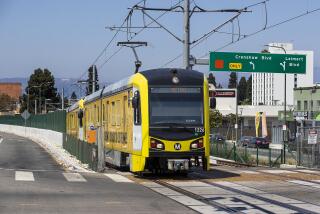TROLLEY: OK Is Given to Start East Line Work : Bayside Trolley Line Given a Green Light
- Share via
Despite concerns over noise, air pollution and traffic problems downtown, the Metropolitan Transit Development Board moved ahead Thursday with plans for the proposed 1.4-mile Bayside Line by approving an environmental impact report on the project.
The board also announced that it had received federal clearance to begin construction on a 5.5-mile extension of the East Line within the next four weeks. The extension will eventually take the trolley from Spring Street in La Mesa to the transit center at Main Street and Marshall Avenue in El Cajon.
Construction had been delayed three months by a contract dispute initiated by Herzog Contracting Corp., the second lowest bidder for the project. But the federal Urban Mass Transportation Administration, which is funding most of the $11.5-million extension, ruled that the project should go forward with Comstock Engineering Inc., the low bidder, as the builder.
In other action, the board adopted station locations and a “preferred alignment” for the proposed 5.9-mile west segment of the Mission Valley trolley line, which will not open until at least the early 1990s. Under the plan, nine stations would be located along the route following the San Diego River.
$40-Million Line
The proposed $40-million Bayside Line, which is scheduled to open by fall of 1989, sparked most of the debate Thursday morning as speakers questioned routing plans, and noise and air pollution they said would result from construction of the semi-circular trolley line. The Bayside Line is proposed to run from Imperial and 12th avenues along L Street, Harbor Drive, and up Pacific Highway to Broadway.
Roy Potter, executive vice-president of San Diegans Inc., which represents downtown business groups, opposed the decision to run trolleys in a “hook” configuration when the line is installed. Under that configuration, trains would proceed to a certain point and reverse, retracing their paths to exit downtown.
Under that plan, the South Line, which starts at the Mexican border, would come north on 12th Avenue head west on C Street and then go north on a planned extension to Grape Street, before reversing direction and heading back along the same route.
The East Line, which currently begins at Euclid Avenue in Southeast San Diego, would go north on 12th Avenue, west on C Street, turn south at the Santa Fe Depot and (becoming the Bayside Line) run past Seaport Village, the future San Diego Convention Center, and along L Street to 12th and Imperial.
But instead of continuing up 12th to form a continuous loop, the trolley would then reverse and re-trace its path to leave the way it came in.
Potter maintained that the configuration will mean 337 miles and 34 hours of “redundant” trolley trips each day, interfering with north-south automobile traffic by preempting traffic signals as the trolley moves along C Street.
By contrast, two loops--one operating clockwise and one counter-clockwise--would more efficiently move people around downtown, eliminating the need for transfers in the Centre City area, he said.
William Lieberman, director of planning and operations for the MTDB, acknowledged the loop’s advantages to downtown travelers, but said that, after much study, planners decided that benefits of the hook configuration outweighed them.
“The advantage of ours is that everybody gets to C Street first, which is is the heart of the business district,” Lieberman said.
The hook configuration also routes travelers into the northern extension, which is scheduled to go to University City, without the need to transfer, which provides more advantages in the long run, Lieberman said.
Lieberman also denied that there would be additional traffic delays as a result of the plan.
MTDB directors, deciding that the hook-loop controversy was not an environmental problem, approved the environmental impact report but agreed to debate the routing policy in two weeks to give planners time to study Potter’s data.
Marilyn Yick, representing residents of Park Row condominiums at 701 Kettner Blvd., asked for changes that would eliminate eight loud warning bells required at spots where the proposed Bayside Line crosses street intersections. The eight bells--four at Kettner and G Street, two where the track crosses F Street and two where the track crosses E Street--will all be heard by the residents of the condominium project, she said. Yick’s group also wants the bells to be ceramic instead of metal to cut down on noise, she said.
Instead, MTDB directors voted to urge the city to make G Street a one-way eastbound street in that area--a change already being planned--and to ask the state Public Utilities Commission to allow the use of traffic signals instead of warning bells. But they expressed little hope that the PUC would approve that measure.
More to Read
Sign up for Essential California
The most important California stories and recommendations in your inbox every morning.
You may occasionally receive promotional content from the Los Angeles Times.













